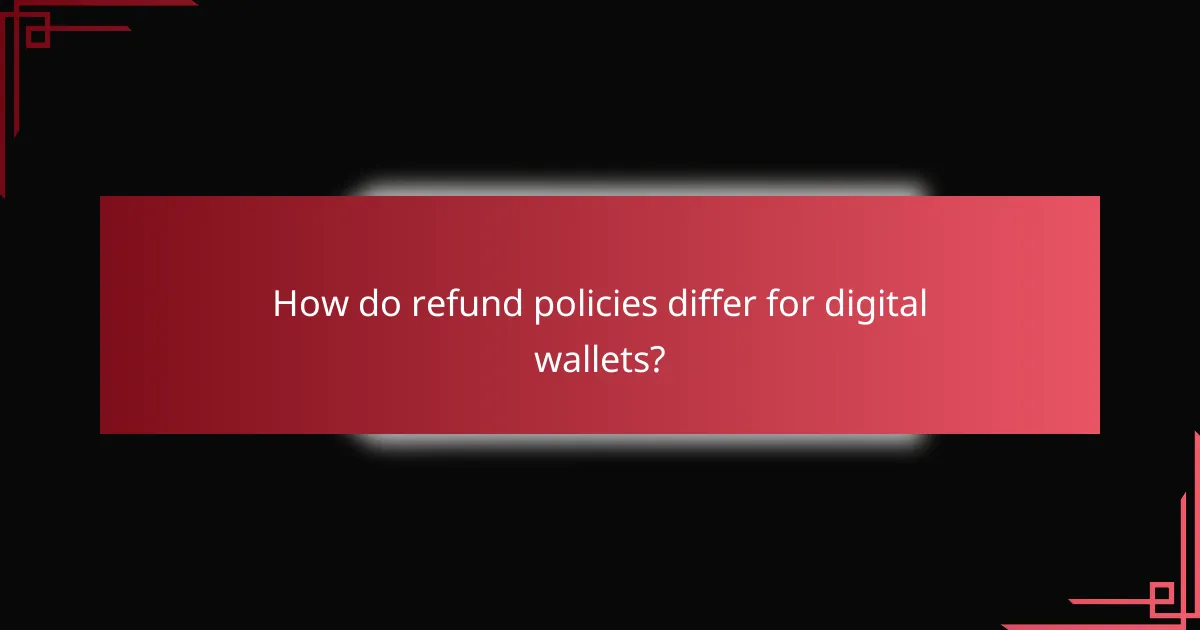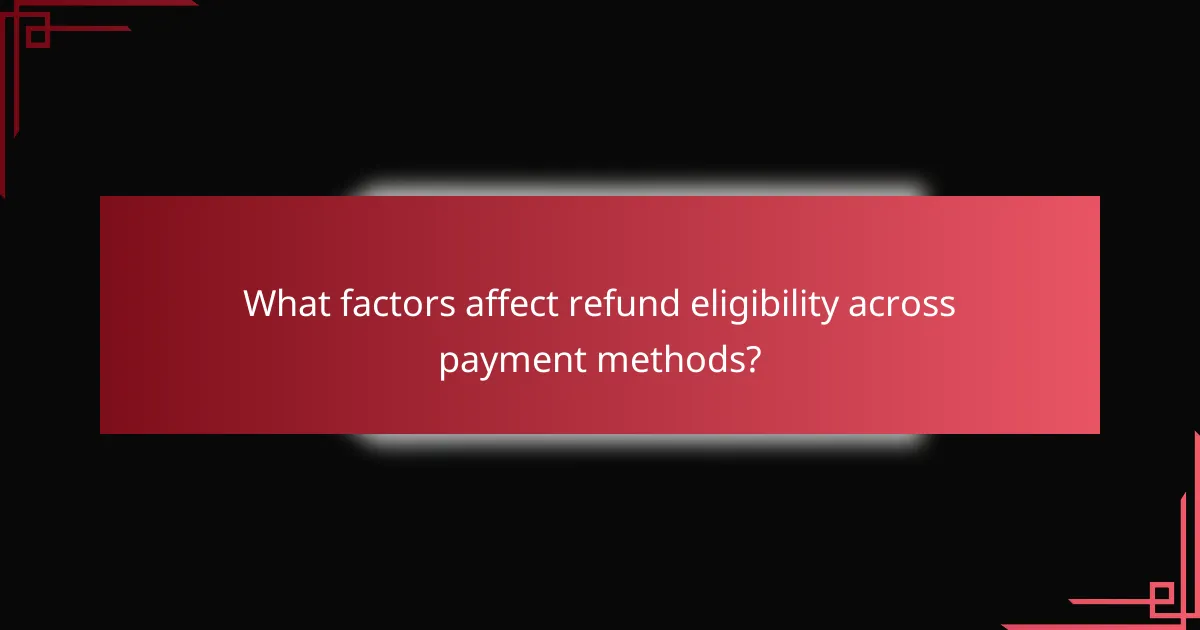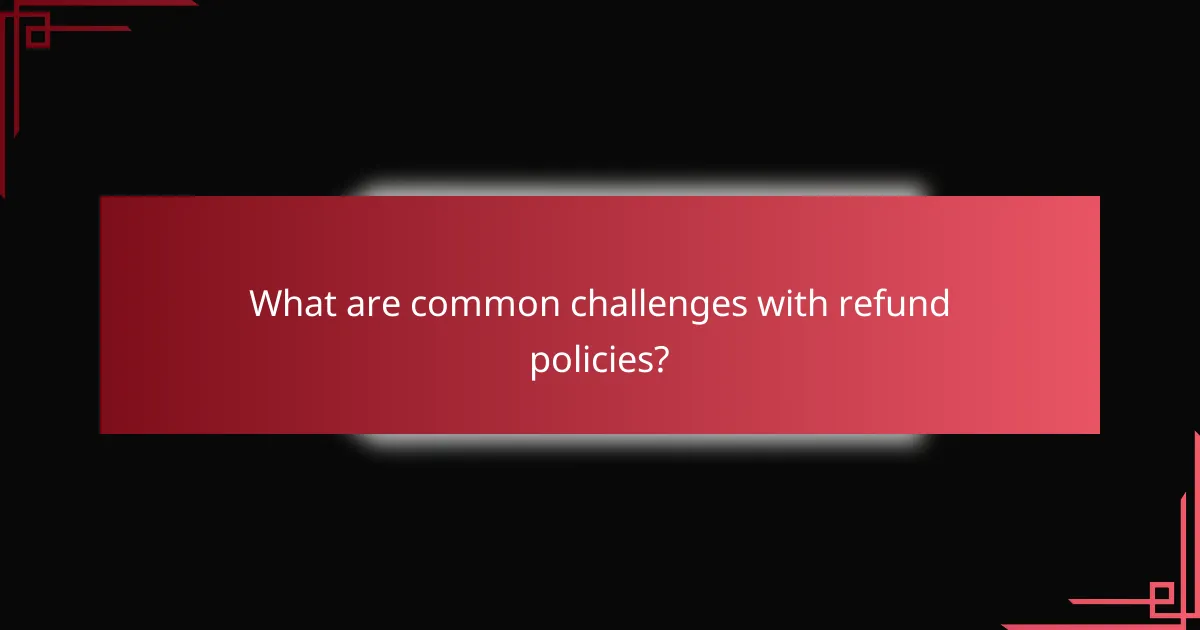Understanding refund policies is crucial for consumers using credit cards, digital wallets, or Buy Now, Pay Later services. Each payment method has its own set of rules regarding how refunds are processed, timelines, and any applicable fees. Familiarizing yourself with these policies can help ensure a smoother return experience and protect your financial interests.

What are the refund policies for credit cards?
Refund policies for credit cards vary by issuer and merchant, but generally, they allow consumers to receive their money back for returned goods or services. Most credit card companies require merchants to process refunds within a specific timeframe, typically ranging from a few days to a couple of weeks.
Visa refund policy overview
Visa’s refund policy emphasizes that refunds must be processed by the merchant through their payment system. Once initiated, the refund typically appears on the cardholder’s account within 3 to 5 business days, depending on the merchant’s processing speed.
Cardholders should retain receipts and transaction records to facilitate any disputes. If a refund is not received in a reasonable time, contacting the merchant first is advisable before escalating to Visa.
Mastercard refund policy overview
Mastercard allows refunds to be processed directly by the merchant, similar to Visa. The timeframe for receiving the refund can vary, but it generally takes around 5 to 7 business days to reflect on the cardholder’s account.
It’s crucial for consumers to be aware of the merchant’s return policy, as some may have specific conditions that could delay the refund. Keeping documentation of the purchase can help in case of disputes.
American Express refund policy overview
American Express has a straightforward refund policy, where merchants must initiate the refund through the American Express system. Refunds are usually processed quickly, often within 1 to 3 business days.
Cardholders can dispute charges if a refund is not received after a reasonable period. American Express provides robust customer service to assist with such issues, making it easier for consumers to resolve disputes.
Discover refund policy overview
Discover’s refund policy requires merchants to process refunds directly. The typical timeframe for a refund to appear on a cardholder’s account is about 3 to 5 business days.
Consumers should check the merchant’s return policy for any specific requirements or time limits. Keeping a record of the transaction can be beneficial if issues arise during the refund process.

How do refund policies differ for digital wallets?
Refund policies for digital wallets can vary significantly based on the provider and the transaction type. Generally, these policies dictate how quickly refunds are processed, any associated fees, and the conditions under which refunds are granted.
PayPal refund policy details
PayPal typically allows users to request refunds for transactions within a specific timeframe, usually up to 180 days. If the seller agrees to the refund, the money is returned to the buyer’s PayPal balance or original payment method, often within a few business days.
It’s important to note that PayPal may charge fees for certain types of transactions, and buyers should review the seller’s return policy before making a purchase. If a dispute arises, PayPal offers a resolution center to help mediate the issue.
Apple Pay refund policy details
Apple Pay does not have a universal refund policy, as refunds are primarily managed by the merchants. Customers should check the specific return policies of the stores where they made purchases using Apple Pay.
Refunds are generally processed back to the original payment method, which can take a few days to reflect in the user’s bank account. Users should retain their receipts and transaction details to facilitate the refund process.
Google Pay refund policy details
Similar to Apple Pay, Google Pay’s refund policies depend on the merchant’s terms. Users should verify the return policy of the retailer before completing a purchase.
Refunds through Google Pay are typically credited back to the original payment method, and processing times can vary. Keeping transaction records can help expedite any refund requests or disputes with merchants.

What are the refund policies for Buy Now, Pay Later services?
Buy Now, Pay Later (BNPL) services typically allow consumers to make purchases and pay for them in installments. Refund policies for these services can vary significantly, so it’s essential to understand the specifics of each provider to ensure a smooth return process.
Affirm refund policy overview
Affirm’s refund policy generally aligns with the merchant’s return policy. If a customer returns an item, they must notify Affirm, and the refund will be processed back to the original payment method. Customers should expect the refund to take several business days to reflect in their account.
It’s important to check with the retailer for their specific return window, as it can range from 30 to 90 days. If the return is initiated within this period, Affirm will adjust the payment schedule accordingly.
Klarna refund policy overview
Klarna’s refund policy is also tied to the merchant’s return policy. When a return is made, Klarna will automatically update the payment plan based on the return confirmation from the retailer. Customers should ensure they follow the return instructions provided by the merchant to avoid complications.
Refunds typically take around 5-10 business days to process, depending on the retailer’s policies. Customers should keep an eye on their Klarna account for updates regarding their payment schedule after a return.
Afterpay refund policy overview
Afterpay requires customers to adhere to the retailer’s return policy for refunds. Once an item is returned, the retailer must notify Afterpay, and the refund will be issued back to the original payment method. Customers should be aware that Afterpay does not handle returns directly.
Refunds can take up to 10 business days to appear in the customer’s account. It’s advisable to check the retailer’s return policy, which often allows returns within 30 days, to ensure a hassle-free process.

What factors affect refund eligibility across payment methods?
Refund eligibility varies based on the payment method used, including factors like time limits, product condition, and specific merchant policies. Understanding these elements can help consumers navigate the refund process more effectively.
Time limits for refunds
Each payment method typically has its own time frame for initiating a refund. For credit cards, this period often ranges from 30 to 120 days after the purchase, while digital wallets may have similar or slightly shorter limits. Buy Now, Pay Later services usually require refunds to be requested within a few weeks of the transaction.
It’s crucial to check the specific terms associated with your payment method, as missing these deadlines can result in losing the right to a refund. Always keep receipts and transaction records to facilitate the process.
Condition of the product
The condition of the product being returned significantly impacts refund eligibility. Most merchants require items to be in their original condition, unused, and with all packaging intact. For example, clothing must often have tags attached, while electronics should not show signs of wear.
Some merchants may offer partial refunds for opened or used items, while others might not accept returns at all. Always review the return policy to understand what is acceptable before making a purchase.
Merchant-specific policies
Each merchant can set its own refund policies, which can differ widely even for similar products. Some retailers may offer generous return windows and hassle-free refunds, while others might impose strict conditions. For instance, online retailers often have more flexible policies compared to brick-and-mortar stores.
It’s advisable to familiarize yourself with a merchant’s specific refund policy before purchasing. Look for details on their website or inquire directly to avoid surprises when seeking a refund.

How to choose the best payment method based on refund policies?
Selecting the right payment method involves understanding how refund policies differ among options like credit cards, digital wallets, and Buy Now, Pay Later services. Each method has unique advantages and potential drawbacks that can affect your ability to receive refunds efficiently.
Comparing credit card benefits
Credit cards often provide robust refund policies, including chargeback options that allow you to dispute transactions. Many issuers offer extended return periods and additional protections for purchases, which can be beneficial if you need to return an item.
However, it’s essential to check the specific terms of your credit card, as benefits can vary widely. Some cards may require you to report issues within a short timeframe, typically around 60 days from the transaction date.
Evaluating digital wallet advantages
Digital wallets, such as PayPal or Apple Pay, often streamline the refund process, allowing for quicker transactions and notifications. Many digital wallets provide buyer protection policies that can help you recover funds if a purchase doesn’t meet expectations.
Keep in mind that while digital wallets can be convenient, their refund policies may not be as comprehensive as those offered by credit cards. Always review the specific terms associated with your digital wallet to understand any limitations.
Assessing Buy Now, Pay Later options
Buy Now, Pay Later (BNPL) services allow you to make purchases and pay over time, but their refund policies can be less straightforward. Generally, refunds are processed through the retailer, and you may still be responsible for payments until the return is finalized.
It’s crucial to read the terms of service for any BNPL provider, as some may charge fees if you return items after a certain period. Understanding these nuances can help you avoid unexpected costs and ensure a smoother refund experience.

What are common challenges with refund policies?
Common challenges with refund policies include confusion over terms, disputes with merchants, and varying processing times. Customers often face difficulties understanding the specific conditions under which refunds are granted, leading to frustration and delays.
Disputes with merchants
Disputes with merchants can arise when customers feel that their refund requests are unjustly denied. This often occurs due to unclear refund policies or differing interpretations of the terms of service. Customers should carefully read the refund policy before making a purchase to avoid misunderstandings.
When a dispute occurs, it’s crucial to communicate directly with the merchant. Documenting all interactions and keeping records of receipts and correspondence can significantly strengthen a customer’s case. If resolution is not achieved, customers may consider escalating the issue through consumer protection agencies or payment dispute channels.
In some cases, merchants may offer store credit instead of a cash refund. While this can be beneficial for future purchases, customers should weigh the value of store credit against their original purchase intent. Understanding the merchant’s policy on refunds and exchanges can help prevent future disputes.
